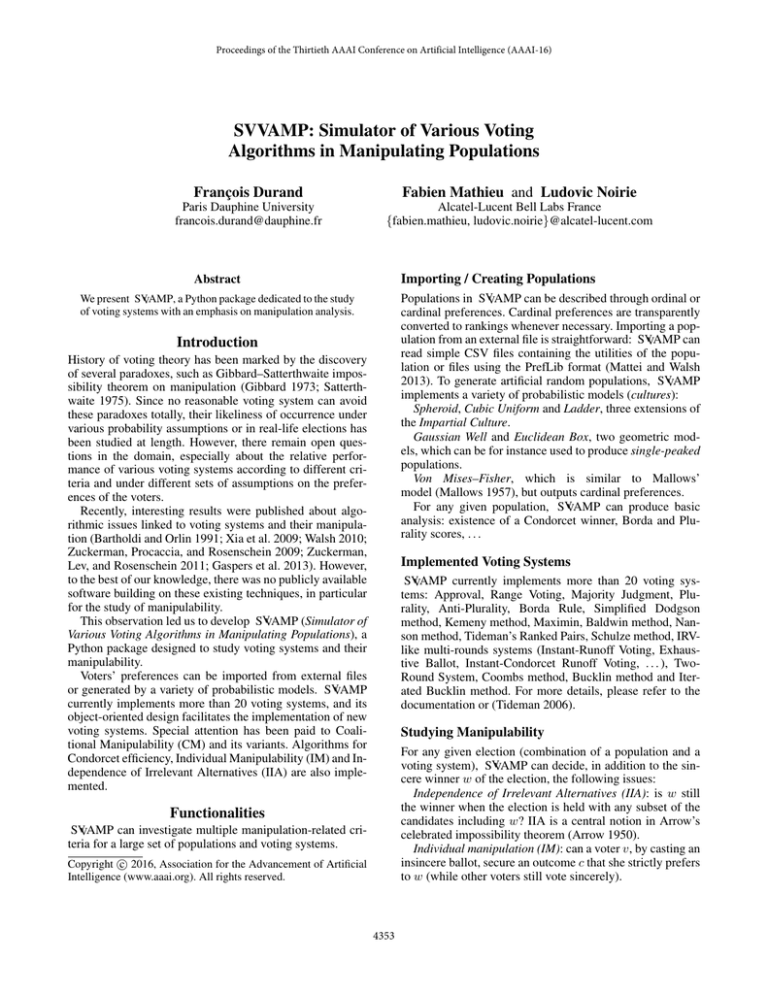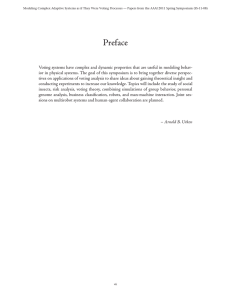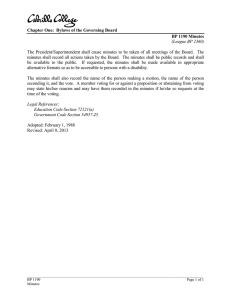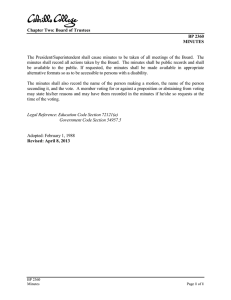
Proceedings of the Thirtieth AAAI Conference on Artificial Intelligence (AAAI-16)
SVVAMP: Simulator of Various Voting
Algorithms in Manipulating Populations
François Durand
Fabien Mathieu and Ludovic Noirie
Paris Dauphine University
francois.durand@dauphine.fr
Alcatel-Lucent Bell Labs France
{fabien.mathieu, ludovic.noirie}@alcatel-lucent.com
Importing / Creating Populations
Abstract
Populations in SVVAMP can be described through ordinal or
cardinal preferences. Cardinal preferences are transparently
converted to rankings whenever necessary. Importing a population from an external file is straightforward: SVVAMP can
read simple CSV files containing the utilities of the population or files using the PrefLib format (Mattei and Walsh
2013). To generate artificial random populations, SVVAMP
implements a variety of probabilistic models (cultures):
Spheroid, Cubic Uniform and Ladder, three extensions of
the Impartial Culture.
Gaussian Well and Euclidean Box, two geometric models, which can be for instance used to produce single-peaked
populations.
Von Mises–Fisher, which is similar to Mallows’
model (Mallows 1957), but outputs cardinal preferences.
For any given population, SVVAMP can produce basic
analysis: existence of a Condorcet winner, Borda and Plurality scores, . . .
We present SVVAMP, a Python package dedicated to the study
of voting systems with an emphasis on manipulation analysis.
Introduction
History of voting theory has been marked by the discovery
of several paradoxes, such as Gibbard–Satterthwaite impossibility theorem on manipulation (Gibbard 1973; Satterthwaite 1975). Since no reasonable voting system can avoid
these paradoxes totally, their likeliness of occurrence under
various probability assumptions or in real-life elections has
been studied at length. However, there remain open questions in the domain, especially about the relative performance of various voting systems according to different criteria and under different sets of assumptions on the preferences of the voters.
Recently, interesting results were published about algorithmic issues linked to voting systems and their manipulation (Bartholdi and Orlin 1991; Xia et al. 2009; Walsh 2010;
Zuckerman, Procaccia, and Rosenschein 2009; Zuckerman,
Lev, and Rosenschein 2011; Gaspers et al. 2013). However,
to the best of our knowledge, there was no publicly available
software building on these existing techniques, in particular
for the study of manipulability.
This observation led us to develop SVVAMP (Simulator of
Various Voting Algorithms in Manipulating Populations), a
Python package designed to study voting systems and their
manipulability.
Voters’ preferences can be imported from external files
or generated by a variety of probabilistic models. SVVAMP
currently implements more than 20 voting systems, and its
object-oriented design facilitates the implementation of new
voting systems. Special attention has been paid to Coalitional Manipulability (CM) and its variants. Algorithms for
Condorcet efficiency, Individual Manipulability (IM) and Independence of Irrelevant Alternatives (IIA) are also implemented.
Implemented Voting Systems
SVVAMP currently implements more than 20 voting systems: Approval, Range Voting, Majority Judgment, Plurality, Anti-Plurality, Borda Rule, Simplified Dodgson
method, Kemeny method, Maximin, Baldwin method, Nanson method, Tideman’s Ranked Pairs, Schulze method, IRVlike multi-rounds systems (Instant-Runoff Voting, Exhaustive Ballot, Instant-Condorcet Runoff Voting, . . . ), TwoRound System, Coombs method, Bucklin method and Iterated Bucklin method. For more details, please refer to the
documentation or (Tideman 2006).
Studying Manipulability
For any given election (combination of a population and a
voting system), SVVAMP can decide, in addition to the sincere winner w of the election, the following issues:
Independence of Irrelevant Alternatives (IIA): is w still
the winner when the election is held with any subset of the
candidates including w? IIA is a central notion in Arrow’s
celebrated impossibility theorem (Arrow 1950).
Individual manipulation (IM): can a voter v, by casting an
insincere ballot, secure an outcome c that she strictly prefers
to w (while other voters still vote sincerely).
Functionalities
SVVAMP can investigate multiple manipulation-related criteria for a large set of populations and voting systems.
c 2016, Association for the Advancement of Artificial
Copyright Intelligence (www.aaai.org). All rights reserved.
4353
Available Code
Coalitional manipulation (CM): can a subset of voters,
by casting insincere ballots, secure an outcome c that they
strictly prefer to w (while other voters still vote sincerely).
Ignorant-Coalition Manipulation (ICM), UnisonManipulation (UM) and Trivial Manipulation (TM), three
alternative types of coalitional manipulation.
SVVAMP is a free software, under GNU General Public License version 3. Its documentation includes installation procedure, tutorials, reference guide and instructions for new
contributors. It is available at:
https://svvamp.readthedocs.org.
We hope that it will be useful to researchers, teachers and
students interested in voting theory.
Technical Details
Algorithms
Acknowledgment
Determining manipulability, especially CM, can be computationally challenging (for example, it is NP-complete for
Borda Rule, Maximin, Coombs method and IRV).
SVVAMP is the first publicly available software implementing state-of-the-art algorithms (Xia et al. 2009; Zuckerman, Procaccia, and Rosenschein 2009; Zuckerman, Lev,
and Rosenschein 2011; Gaspers et al. 2013; Walsh 2010)
and original heuristics. By default, it tries its most precise
algorithm among those running in polynomial time (exact
computation can be specified). Approximations conventionally return nan if they cannot decide.
SVVAMP also embeds brute force algorithms to provide exact computation for any voting system (only recommended for small instances).
The work presented in this paper has been carried out at
LINCS (http://www.lincs.fr).
References
Arrow, K. 1950. A difficulty in the concept of social welfare.
The Journal of Political Economy 58(4):328–346.
Bartholdi, J., and Orlin, J. 1991. Single transferable vote
resists strategic voting. Social Choice and Welfare 8:341–
354.
Gaspers, S.; Kalinowski, T.; Narodytska, N.; and Walsh,
T. 2013. Coalitional manipulation for Schulze’s rule. In
Proceedings of the 2013 international conference on Autonomous agents and multi-agent systems, 431–438.
Gibbard, A. 1973. Manipulation of voting schemes: A general result. Econometrica 41(4):587–601.
Mallows, C. 1957. Non-null ranking models. Biometrika
114–130.
Mattei, N., and Walsh, T. 2013. Preflib: A library of preference data. In Proceedings of Third International Conference
on Algorithmic Decision Theory (ADT 2013).
Satterthwaite, M. 1975. Strategy-proofness and Arrow’s
conditions: Existence and correspondence theorems for voting procedures and social welfare functions. Journal of Economic Theory 10(2):187–217.
Tideman, N. 2006. Collective Decisions And Voting: The
Potential for Public Choice. Ashgate.
Walsh, T. 2010. Manipulability of single transferable vote.
In Computational Foundations of Social Choice, number
10101.
Xia, L.; Zuckerman, M.; Procaccia, A.; Conitzer, V.; and
Rosenschein, J. 2009. Complexity of unweighted coalitional
manipulation under some common voting rules. In International Joint Conference on Artificial Intelligence, 348–353.
Zuckerman, M.; Lev, O.; and Rosenschein, J. 2011. An algorithm for the coalitional manipulation problem under Maximin. In The 10th International Conference on Autonomous
Agents and Multiagent Systems - Volume 2, 845–852.
Zuckerman, M.; Procaccia, A.; and Rosenschein, J. 2009.
Algorithms for the coalitional manipulation problem. Artificial Intelligence 173(2):392–412.
Architecture
SVVAMP is written in a modular way. For instance, testing
CM is defined in class Election and calls a set of specific
sub-functions. Each of these sub-functions can be overridden in the subclass implementing a specific voting system,
while keeping the others. This facilitates the definition of
new voting systems.
These generic methods defined in SVVAMP allow developers to quickly define a new voting system, only by its rule,
and already benefit from generic manipulation algorithms,
which makes SVVAMP easily extensible.
Voting systems also come with special attributes that represent a variety of properties that are used to avoid unnecessary computations. For instance, if a voting systems verifies
the Condorcet criterion and if a population admits a Condorcet winner, then SVVAMP immediately concludes that the
corresponding election meets the IIA criterion.
Also note that SVVAMP tries to be as lazy as possible. For
example, if asked to determine if an election is CM, it will
first perform some preliminary checks based on election’s
properties, then it will cycle through the candidate until it
finds a manipulation. If later one wants to get the list of
candidates for which a manipulation is possible, SVVAMP
resumes the computation where it stopped.
Performance
SVVAMP is designed to run large scale experiments on regular computers. To give an order of magnitude, a full study
of all voting systems on 10 000 populations drawn with the
Spheroid culture, with V = 33 voters and C = 5 candidates
takes less than one half-hour on a 2.3 GHz personal laptop.
4354







